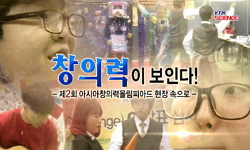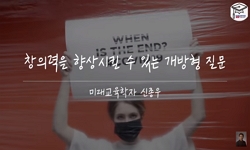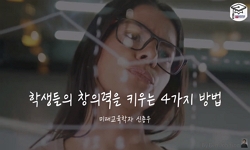창의적 인재는 다양한 아이디어를 발휘하여 문제 상황을 해결해 나갈 능력을 가진 사람으로서 국제화와 진전될수록 너무나 필요한 인적 자원이다. 우리가 간과하지 말아야 할 것은 튼튼하...
http://chineseinput.net/에서 pinyin(병음)방식으로 중국어를 변환할 수 있습니다.
변환된 중국어를 복사하여 사용하시면 됩니다.
- 中文 을 입력하시려면 zhongwen을 입력하시고 space를누르시면됩니다.
- 北京 을 입력하시려면 beijing을 입력하시고 space를 누르시면 됩니다.
https://www.riss.kr/link?id=T12928209
- 저자
-
발행사항
대전 : 忠南大學校 敎育大學院, 2012
-
학위논문사항
학위논문(석사) -- 忠南大學校 敎育大學院 , 교육학과 미술교육 전공 , 2012. 8
-
발행연도
2012
-
작성언어
한국어
- 주제어
-
DDC
750 판사항(22)
-
발행국(도시)
대전
-
형태사항
82 p : 삽화 ; 26 cm.
-
일반주기명
충남대학교 논문은 저작권에 의해 보호받습니다.
지도교수:임립
부록: 사전조사 설문지
참고문헌 : p. 72-74 - 소장기관
-
0
상세조회 -
0
다운로드
부가정보
국문 초록 (Abstract)
첫째, 전통에 대한 인식이 변화되고 전통에 대한 관심이 높아졌다는 점이다. 현대 작가들의 전통 작품 응용 사례를 보면서 우리 민족 고유의 문화예술에 대한 적극적 관심이 향상되었다. 옛 것을 옛 것 그대로만 받아들이는 것이 아닌 오늘날 우리의 시대에 맞게 영상 매체나 사진으로 응용된다는 것이 새로운 자극으로 받아들여진 것으로 나타났다.
둘째, 전통적인 것이 다양한 방법으로 응용되고 변형되는 사례들을 보면서 다양한 응용 기법, 다양한 재료에 대한 관심이 높아졌다. 음식이나 모래, 유리를 소재로 하는 새로운 재료와 방법을 모색하고 탐색하는 변화가 나타났다. 그래서 기존 사물의 고정관념에서 벗어나 자유롭고 창의적인 발상에 한발자국 다가가는 계기가 되었다. 사물의 용도가 기존의 자리에만 있는 것이 아닌, 또 다른 용도로 이용될 수 있음을 인식하고 고정관념의 벽이 허물어졌다고 볼 수 있다.
이상과 같은 연구결과가 교육현장에서 적용되기 위해선 먼저 교사 자신이 우리의 전통미술에 대해 보다 정확히 이해하고 알아야 하며 다양한 재료사용의 사례와 자유와 자율이 허용된 분위기의 토론식 수업을 이행해야 할 것이다.
창의적 인재는 다양한 아이디어를 발휘하여 문제 상황을 해결해 나갈 능력을 가진 사람으로서 국제화와 진전될수록 너무나 필요한 인적 자원이다. 우리가 간과하지 말아야 할 것은 튼튼하고 견고한 창의적 발상이 나오기 위해서는 오랜 시간 우리 민족에 뿌리 내려진 전통이라는 기반이 있어야 깊이 있고 의미 있는 창작이 탄생된다는 것이다. 또한 국제화가 진전될수록 각 민족의 고유문화에 대한 관심은 점점 높아지게 됨은 분명하다. 민족적 열등감이 아닌 민족적 자긍심이나 민족적 정체성을 갖는다는 것은 우리의 뿌리인 전통문화에 대한 이해와 자부심을 가지고 있을 때 가능한 일이다. 그렇기 때문에 학교교육현장에서도 개인의 창의성 신장과 전통 미술 교육 수업 연구가 필요한 실정이다. 이에 본 연구에서는 창의력의 개념 연구, 전통미술 교육의 연구, 전통 미술과 창의력과의 관계, 전통 미술교육의 창의적 접근에 대한 이론적 배경을 연구하였다. 그 결과 창의성 향상과 전통 미술 접근에 어떠한 도움이 되었는지 2가지로 요약되었다.
첫째, 전통에 대한 인식이 변화되고 전통에 대한 관심이 높아졌다는 점이다. 현대 작가들의 전통 작품 응용 사례를 보면서 우리 민족 고유의 문화예술에 대한 적극적 관심이 향상되었다. 옛 것을 옛 것 그대로만 받아들이는 것이 아닌 오늘날 우리의 시대에 맞게 영상 매체나 사진으로 응용된다는 것이 새로운 자극으로 받아들여진 것으로 나타났다.
둘째, 전통적인 것이 다양한 방법으로 응용되고 변형되는 사례들을 보면서 다양한 응용 기법, 다양한 재료에 대한 관심이 높아졌다. 음식이나 모래, 유리를 소재로 하는 새로운 재료와 방법을 모색하고 탐색하는 변화가 나타났다. 그래서 기존 사물의 고정관념에서 벗어나 자유롭고 창의적인 발상에 한발자국 다가가는 계기가 되었다. 사물의 용도가 기존의 자리에만 있는 것이 아닌, 또 다른 용도로 이용될 수 있음을 인식하고 고정관념의 벽이 허물어졌다고 볼 수 있다.
이상과 같은 연구결과가 교육현장에서 적용되기 위해선 먼저 교사 자신이 우리의 전통미술에 대해 보다 정확히 이해하고 알아야 하며 다양한 재료사용의 사례와 자유와 자율이 허용된 분위기의 토론식 수업을 이행해야 할 것이다.
다국어 초록 (Multilingual Abstract)
The purpose of this research is to define the meaning of creativity, tradtional art education, the relation between traditional art and creativity, and the creative approach toward traditional art education.
The method used to conduct this research is firstly, we chose 300 students to understand their perception and current situation on creative art education. Secondly, we found traditional art areas and people with creative art skills and work from art textbooks currently used and made an educational manual. After using that manual, we interviewed students and analyzed the result. Furthermore, we stated the advantages and disadvantages of using the teaching manual.
We can summarise how this research can affect creativity growth and the approach to traditional art, into two categories.
Firstly, students have changed their notion about tradition and have a deeper interest in it. Since they have witnessed examples of applied traditional art, their interest levels have risen. Students stated that, contrary to their natural tendencies, traditional art does not have to be considered an outdated practice. They can apply traditional art on contemporary visual media and pictures. Overall, students were able to accept it as new stimulation.
Secondly, looking at many examples of tradition shows various aspects in itself through many different applications, which sparks a students' interest in various application methods and substances. They used food, sand, and glass to seek for newer art methods. What they found was that they were able to escape from fixed ideas and journey into a mental place full of freedom and creativity. Students got to know that many objects were able to be used in different ways, which tore down the wall of conventionalism.
To successfully apply this educational method, teachers should understand our traditional art accurately, show examples of using various substances, and create open and engaging brainstorming sessions between teachers and students.
Creative people are those who possess various ideas and have an innate ability to solve problems. They are a very necessary manpower with a vast effect on internationalism and globalism. Art is based on creativity more than any other subject, therefo...
Creative people are those who possess various ideas and have an innate ability to solve problems. They are a very necessary manpower with a vast effect on internationalism and globalism. Art is based on creativity more than any other subject, therefore creativity development is an essential part of art education. The fact that should not be ignored, however, is that though innovation needs to be fostered, keeping to our traditions is just as important. So, we can create deep and meaningful art and at the same time stay true to our nationalism. Furthermore, as internationalism and globalization develops, people have a growing interest in each country's individual cultures, through the arts. In order to maintain our country's pride, we need to understand our background as a nation. Therefore, in school, we need educational research to develop creativity and traditional culture education.
The purpose of this research is to define the meaning of creativity, tradtional art education, the relation between traditional art and creativity, and the creative approach toward traditional art education.
The method used to conduct this research is firstly, we chose 300 students to understand their perception and current situation on creative art education. Secondly, we found traditional art areas and people with creative art skills and work from art textbooks currently used and made an educational manual. After using that manual, we interviewed students and analyzed the result. Furthermore, we stated the advantages and disadvantages of using the teaching manual.
We can summarise how this research can affect creativity growth and the approach to traditional art, into two categories.
Firstly, students have changed their notion about tradition and have a deeper interest in it. Since they have witnessed examples of applied traditional art, their interest levels have risen. Students stated that, contrary to their natural tendencies, traditional art does not have to be considered an outdated practice. They can apply traditional art on contemporary visual media and pictures. Overall, students were able to accept it as new stimulation.
Secondly, looking at many examples of tradition shows various aspects in itself through many different applications, which sparks a students' interest in various application methods and substances. They used food, sand, and glass to seek for newer art methods. What they found was that they were able to escape from fixed ideas and journey into a mental place full of freedom and creativity. Students got to know that many objects were able to be used in different ways, which tore down the wall of conventionalism.
To successfully apply this educational method, teachers should understand our traditional art accurately, show examples of using various substances, and create open and engaging brainstorming sessions between teachers and students.
목차 (Table of Contents)
- 국문초록 1
- Ⅰ. 서론 3
- 1 연구의 필요성 3
- 2 연구 방법 및 범위 8
- Ⅱ. 이론적 배경 10
- 국문초록 1
- Ⅰ. 서론 3
- 1 연구의 필요성 3
- 2 연구 방법 및 범위 8
- Ⅱ. 이론적 배경 10
- 1. 창의성에 관한 연구 10
- 1) 창의성의 개념과 구성요소 10
- 2) 미술 교육에서의 창의성 12
- 3) 창의적 미술교육의 개념과 배경 15
- 4) 창의성 향상의 전통 미술 교육 사례 17
- 2. 전통미술 교육 19
- 1) 전통미술 교육의 개념 19
- 2) 전통미술 교육의 특징 21
- 3) 전통미술의 교육과 창의력과의 관계 21
- 4) 전통미술과 서양미술의 차이 24
- 3. 전통 미술교육의 창의적 접근 29
- 1) 전통 미술의 접근 방법 29
- 2) 전통 미술의 현대적 수용 30
- 3) 전통 미술 교육의 지도 방향 32
- Ⅲ. 연구 방법 36
- 1.학습 지도안을 개발하기 위한 사전 조사 36
- 1) 창의적 수업에 대한 학생들의 인식조사 36
- 2) 실태조사와 학습 지도안과의 관계 40
- 2. 중등 미술교과서 분석 41
- 1) 전통 미술 영역 단원 분석 41
- 2) 교과서에 나타난 현대의 창의적 기법 46
- 3. 학습지도안 개발 47
- 1) 전통미술의 현대적 응용 47
- 2) 진경산수화와 콜라주 50
- 3) 풍속화와 포토콜라주 54
- 4. 수업 실행 61
- 5. 수업 효과에 대한 조사와 결과 63
- 1) 표적집단면접과 질문지 구성 63
- 2) 면접 결과 64
- 6. 프로그램의 장단점과 보완점 66
- Ⅴ. 결론 69
- Ⅵ. 참고 문헌 72
- 부록 75
- ABSTRACT 80












